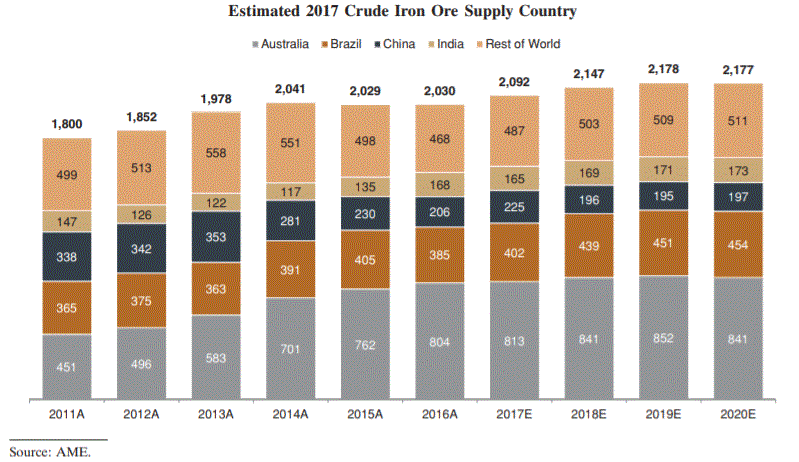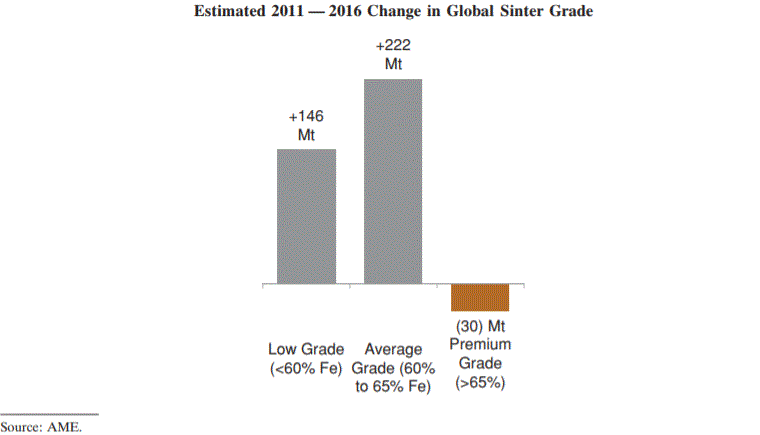The following content is excerpted from the prospectus of Tacora Resources Inc. dated February 5, 2018 filed on SEDAR.
Iron Ore Supply
AME Consulting Group Ltd. ("AME") estimates global 2017 iron ore supply at approximately 2.1 billion dmt, a 3% growth from 2016. The
growth is attributed to new projects as well as growth from smaller producers in major producing regions. In
2017, it is estimated that nearly 50% of the iron ore supply was produced by four major producers: Vale, Rio
Tinto, BHP Billiton and Fortescue Metals Group. The supply of iron ore is also concentrated by region with
Australia, Brazil and China together accounting for approximately 69% of the global iron ore supply.
As is shown in the chart below, iron ore supply is expected to reach approximately 2.2 billion dmt by 2020.
The supply of iron is highly concentrated by region. Australia and China are expected to make up over 1 billion
dmt of demand in 2020 and produce lower grade iron ore. Australia's iron ore is typically approximately 55%
iron and many Chinese mines produce iron ore around 20 - 30% iron. The significant proportion of the future
global supply that is expected to be made up of low grade iron ore, which will require blending with higher grade
concentrate, increases the expected future demand for high grade iron ore.

Source: Prospectus of Tacora Resources Inc. dated February 5, 2018
Historically, iron ore operations were concentrated in areas where large-scale high grade ore could be
extracted at low cost. These operations typically required little to no beneficiation and are referred to as "direct
ship" operations. As global demand for iron ore has grown, new projects have been brought online at
progressively lower grades, while high grade supply has declined. As is shown in the chart below, between 2011
and 2016 the supply of low and average grade ore increased substantially, while the supply of high grade ore
(>65% Fe) decreased. This trend is indicative of the evolving global supply dynamics increasing the supply of
lower grade ore.

Source: Prospectus of Tacora Resources Inc. dated February 5, 2018
Iron Ore Market
 Iron Ore Demand >>
Iron Ore Demand >>
Iron ore products come in many varieties (pellet, lump, concentrate, sinter feed, etc.), quality ranges
(judged based on presence of deleterious elements like phosphorus, alumina, silica), grades (iron percentage)...
More >>
 Iron Ore Supply >>
Iron Ore Supply >>
AME estimates global 2017 iron ore supply at approximately 2.1 billion dmt, a 3% growth from 2016. The
growth is attributed to new projects as well as growth from smaller producers in major producing regions...
More >>
 Iron Ore Pricing >>
Iron Ore Pricing >>
Iron ore was historically priced through annual negotiations between the world's largest steelmakers and
their suppliers. However, in recent years, the Platts 62% Fe Fines CFR North China...
More >>
 Iron Ore Types >>
Iron Ore Types >>
Iron ore comes in many chemical formulations (minerals), with the three most common forms being
hematite, magnetite and goethite. While iron ore deposits were traditionally predominantly hematite...
More >>
 Iron Ore Quality >>
Iron Ore Quality >>
Iron ore comes in many chemical formulations (minerals), with the three most common forms being
hematite, magnetite and goethite. While iron ore deposits were traditionally predominantly hematite...
More >>